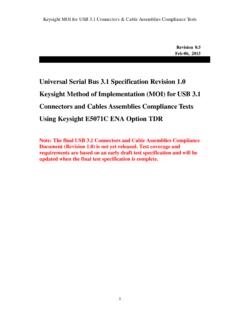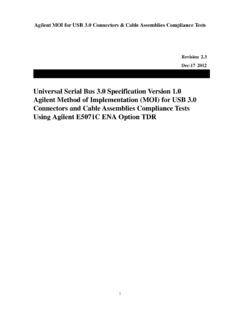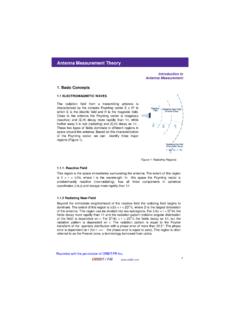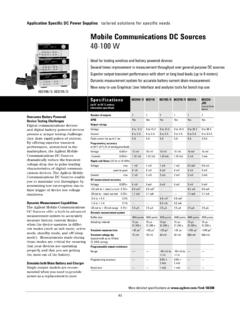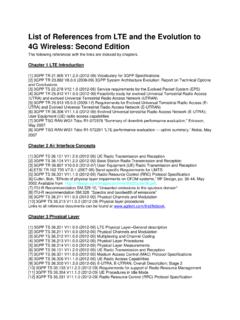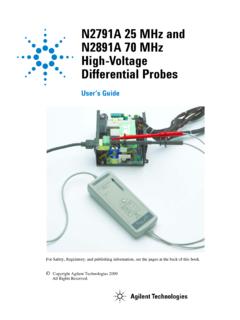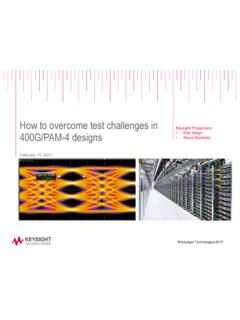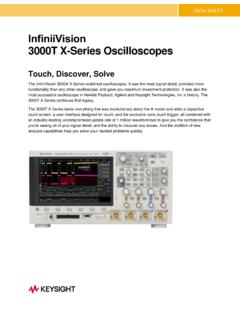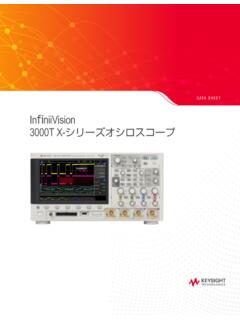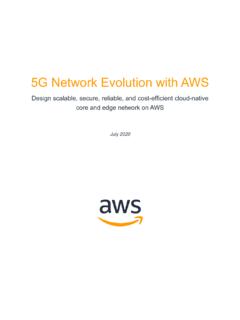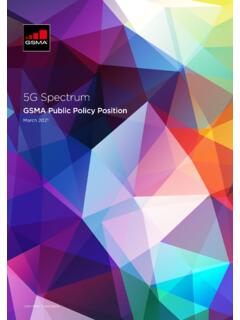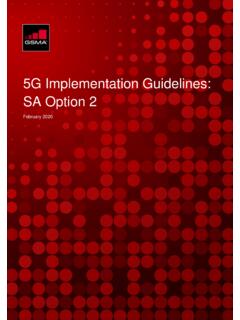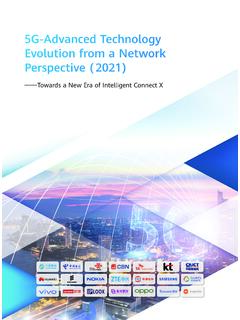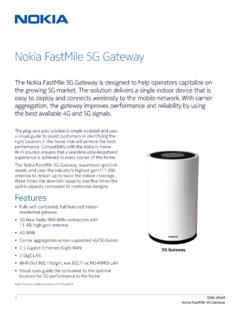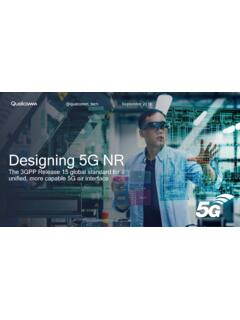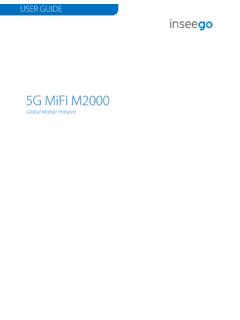Transcription of How to Ensure C-V2X Functional Performance and 2021 ...
1 How to Ensure C-V2X . Functional Performance and 2021. Conformance Requirements Introduction Autonomous vehicles (AVs) depend on technologies that enable greater situational awareness: observing, predicting, and automatically taking action. Cellular vehicle-to-everything ( C-V2X ) has emerged as a wireless link that can help developers achieve higher levels of autonomous operation. However, because C-V2X is built on the evolving 3 GPP releases and with many regulatory bodies overseeing the automotive industry, test requirements are a moving target. Conformance to global and regional standards remains challenging, as different countries have different standards for V2X communications. In laying the foundation of these challenges, this paper will discuss the role of C-V2X in enabling automated driving, 3 GPP releases as it pertains to the automotive industry, and the intelligent transportation system (ITS) stack. Various use cases from multiple regions will be reviewed before proposing a solution that is in-step with evolving C-V2X requirements.
2 This solution should not only support RF, protocol, and application-layer testing, but the underlying platform must also support future releases of 5G NR V2X. This will Ensure C-V2X Functional Performance and 2021 conformance requirements while you focus on accelerating the deployment of the technologies that enable advanced AV capabilities. Find us at Page 1. The Role of C-V2X In Enabling Automated Driving Benefits to Society Cellular-V2X fits into the automotive industry with the concept of Connected Automated Vehicles (CAV). CAV is one of the key technologies and major technological advancements that will influence and shape mankind's future mobility and quality of life. Naturally, safety is a primary concern as higher levels of automated driving are achieved. Of more than 1 million people killed per year on the roads around the world, it is estimated that 98% of those are caused by human error. Removing, or significantly reducing the human element through C-V2X and CAV could help drive the industry to zero fatalities or possibly even zero accidents!
3 Another key concern is that of efficiency and other environmental objectives. An efficient transport system can alleviate vehicle congestion and minimize overall carbon emissions as the time spent driving in bumper-to-bumper traffic is reduced. Another benefit is the improvement of quality of life as the once- focused-driver is now freed to spend their time on other more productive and relaxing activities such as clearing out email, watching that latest episode from a favorite TV series, or even spending much needed time talking with family or friends. This will encourage social inclusion of not only those regular drivers but also those that might suffer from a physical impairment or disability which would otherwise prevent them from driving. With C-V2X and CAV, freedom of travel can be restored to these individuals affording them opportunities to re-enter society, visit friends and family, or experience the countryside instead of being isolated and alone at home.
4 Non-Line of Sight Communications Some of the more common technologies available to enable highly automated vehicles are radar, camera, vision systems, lidar, ultrasonic, 3D HD maps, and precise positioning capabilities. But with the inclusion of C-V2X (sometimes interchangeably referred to as LTE V2X), augmented and enhanced capabilities such as non-line of sight communications will enhance safety and higher levels of automation can be achieved. Provides 360 NLOS awareness, works at night and in bad weather conditions. Figure 1: Non-Line of Sight Sensing Find us at Page 2. Figure 2: Vehicle to Everything (V2X) Communications The above is a pictorial representation depicting the functionality and interactions offered by C-V2X . The term V2X stands for vehicle-to-everything communication and the prefix letter C represents the cellular communications component of this technology. There are several different modes of communication shown that serve to bring enhanced measures of safety and higher levels of automation.
5 Vehicle-to-vehicle (V2V) providing direct communications between vehicles exchanging information such as speed, location, and direction data to facilitate collision avoidance. Vehicle-to-infrastructure (V2I) providing direct connections between the vehicle and road infrastructures such as traffic lights and road signs. Vehicle-to-network (V2N) providing bi-directional connections with communication networks such as 5G, LTE cellular towers, and local hotspots. Vehicle-to-pedestrian (V2P) providing direct communication of safety and proximity alerts to pedestrians, runners, bicyclists, etc. With C-V2X , the concept of a fully connected system emerges where vehicles talk with other vehicles, roadside infrastructure, and mobile networks while working to keep those nearby at a safe distance. C-V2X enables the vehicle to become more automated, more reliable, more dependable, and safer. As mentioned previously, several safety technologies already exist in vehicles eg Radar, LiDAR, etc but it is the addition of C-V2X that uniquely merges and enhances their utility.
6 These pre-existing technologies work with what is known as line of sight, they only interact with what is in front of the vehicle. C-V2X provides 360-degree non-line-of-sight awareness to the vehicle using RF cellular communication technology. This provides a much-needed advance warning to detect and avoid potential danger scenarios, hidden obstacles, or other events. Consider this scenario: Find us at Page 3. As your vehicle approaches an intersection, another vehicle comes from a cross street that has a red light. The vehicle is not slowing down. Your vehicle, designed with C-V2X , receives a signal of the oncoming dangerous situation and automatically starts applying the brakes, thus providing you sufficient time to slow down and avoid colliding with the other vehicle. That is the underlying concept and benefit of C-V2X . In essence, it is a signaling or communications mechanism sending information from vehicle to vehicle or vehicle to infrastructure with the sole purpose of enhancing safety and improving and preserving overall quality of life.
7 3 GPP Releases for Automotive and C-V2X Physical Layer Overview There are two different modes within C-V2X : Direct-mode (otherwise known as mode 4), and Network-based mode (known as mode 3). Direct-mode utilizes straight communications as in Vehicle- to-Vehicle (V2V), Vehicle-to-Infrastructure (V2I), and Vehicle-to-Pedestrian (V2P) working within the ITS. band of GigaHertz and is independent of any network. Network-based mode , is part of the cellular network, which includes Vehicle-to-Network (V2N) infrastructure to Network (I2N), and Pedestrian-to- Network (P2N) in bands designated for mobile communication networks. Some devices support both modes, but most devices in development today are Direct-mode only. The 3rd Generation Partnership Project (3 GPP) is a term representing seven organizations that develop protocols for cellular communications. Each release of their standards can be traced to new protocols and communication technologies such as GSM, wideband CDMA, 2G, 3G, 4G (LTE), and 5G.
8 In 2015, the standards for C-D2D (device to device) was released and are seen as the precursor to C-V2X . The C-V2X was defined in release 14 which enhanced and improved C-D2D to take into account the vehicular environment which introduced doppler shift and considerations for traveling at higher speeds. Release 15 included 5G and some minor enhancements to C-V2X but Release 16, completed late 2020. provides 5G New Radio in the sidelink (or direct communication mode) and for the V2X network. As shown below, a continuous stream of releases and enhancements have occurred and continue to be planned into the future which underscores the need for an up-to-date solution that is completely in-step with these changing protocols and specifications. Figure 3: 3 GPP Release Timeline Find us at Page 4. Release 14 LTE. In the physical layer of release 14, the C-V2X sidelink utilizes SC-FDMA and supports 10 MHz and 20 MHz channels. Each channel is divided into sub-frames and sub-channels which can be referred to as resource blocks (the red blocks Figure 4).
9 Each sub-frame is one millisecond long and is the equivalent of two slots. A resource block (RB) is the smallest unit of frequency resource that can be allocated to an LTE user and is 180 kHz wide in frequency (12 sub-carriers of 15 kHz) by ms (1 time slot). Figure 4: Release 14 resource blocks C-V2X defines sub-channels as a group of RBs in the same sub-frame; the number of RBs per sub- channel can vary, depending on the modulation coding scheme. These sub-channels are used to transmit data and control information (the green blocks in Figure 4) and the data becomes transmitted in the transport blocks (TBs). This concept of RBs is what defines an LTE network and is used in release 14. Release 15 5G for Major Industry Verticals Release 15 is significant as it introduced 5G to the industry and includes the concepts of industry verticals and network slicing. However, this release only provided some minor enhancements to C-V2X as described below.
10 Carrier Aggregation for Mode 4 various mechanisms to support multiple PC5 links. 64-QAM the ability to support the scaling of transport block up to 64-QAM over the previous limitation of one QPSK for each carrier. Tx Diversity the use of multiple antennas for increased transmission reliability. Figure 5: 5G Industry Verticals. Source: 5G-ACIA. Reduced Latency reductions in the time between packet arrival and resource selection for transmission. Find us at Page 5. Release 16 Next Big Release for C-V2X . Release 16 will introduce 5G New Radio (NR) to the sidelink. It will also bring significant advantages to the automotive industry by providing ultra-high reliability and ultra-low latency of mobile broadband connections. Specifically for C-V2X , this release includes Scalable OFDN interfaces support for numerology leading to higher data rates and higher bandwidths. Self-contained slot structures with immediate feedback allowing for a very reliable communication system with low latency.
